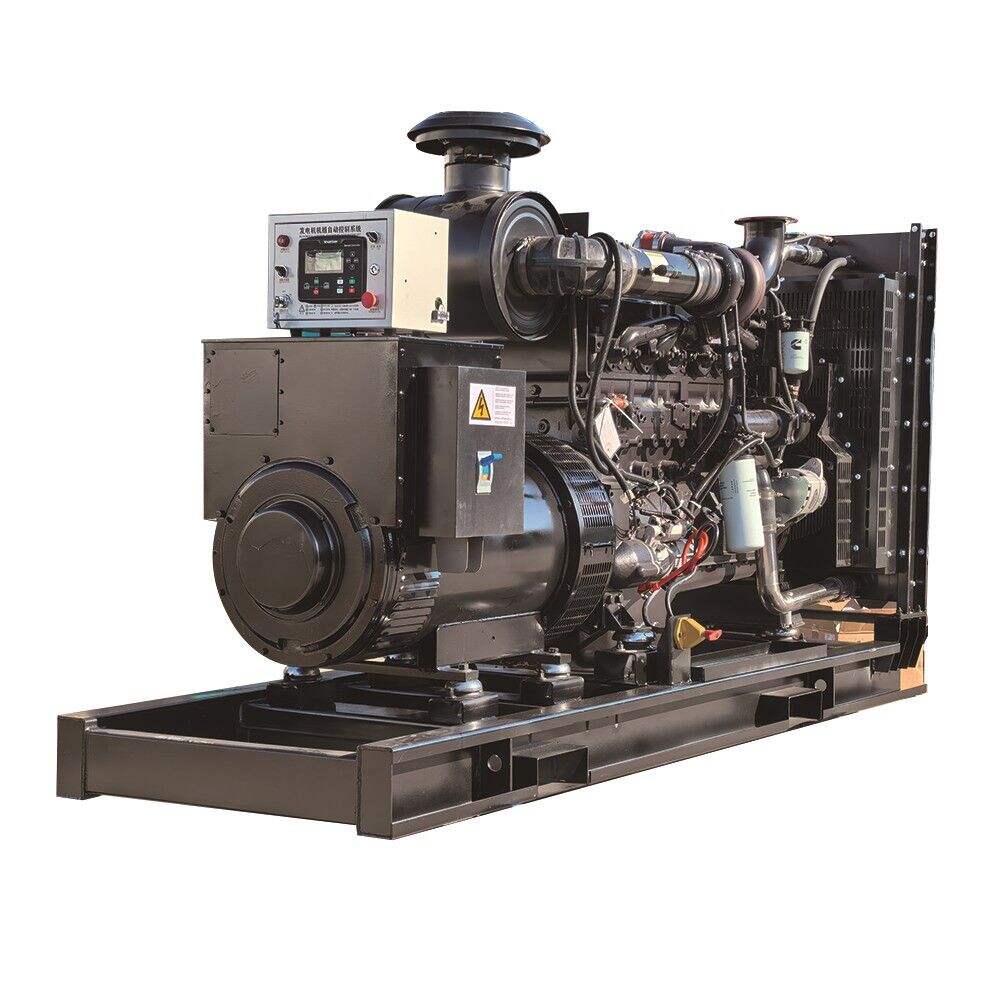When investing in industrial power generation equipment, the warranty and support services provided by your generator manufacturer can significantly impact your long-term operational success. Understanding the nuances of warranty coverage, service availability, and technical support offerings helps businesses make informed decisions that protect their investments and ensure reliable power delivery when it matters most.

The industrial generator market features numerous established brands, each offering distinct warranty structures and support frameworks. Major players in the industry have developed comprehensive service networks spanning multiple continents, while regional manufacturers often provide specialized support tailored to local market conditions. The diversity in warranty terms reflects different business philosophies regarding customer relationships and equipment reliability expectations.
Warranty duration represents just one aspect of the overall support package. Some manufacturers emphasize extended coverage periods, while others focus on comprehensive component protection or enhanced service response times. The most effective warranty programs combine multiple elements to create a holistic support ecosystem that addresses both routine maintenance needs and unexpected equipment failures.
Standard Warranty Coverage Analysis
Basic Warranty Terms Across Leading Brands
Most established generator manufacturers offer standard warranty periods ranging from two to five years, depending on the equipment category and intended application. Standby generators typically receive longer warranty coverage compared to prime power units, reflecting the different operational stresses these applications impose on generator components. The warranty clock usually starts from the date of commissioning or first operation, rather than the purchase date.
Coverage typically includes major components such as engines, alternators, control systems, and factory-installed accessories. However, the specific definition of covered components varies significantly between manufacturers, with some providing comprehensive protection while others limit coverage to core mechanical elements. Understanding these distinctions helps buyers evaluate the true value proposition of different warranty offerings.
Labor coverage represents another critical consideration, as warranty repairs can involve substantial service costs beyond parts replacement. Leading manufacturers generally include labor charges within their warranty terms, while some budget-focused brands may limit coverage to parts only. The geographic scope of labor coverage also varies, with some manufacturers providing global service while others restrict coverage to specific regions.
Extended Warranty Options and Limitations
Extended warranty programs allow customers to extend coverage beyond standard terms, typically offering protection for up to ten years or specific operating hour thresholds. These programs often include enhanced service benefits such as priority response times, preventive maintenance schedules, and dedicated technical support channels. The cost of extended warranties varies based on equipment size, application type, and desired coverage level.
However, extended warranties frequently include operational limitations that can affect coverage validity. Common restrictions include maximum annual operating hours, required maintenance intervals performed by authorized service providers, and environmental operating conditions. Violating these requirements can void extended warranty coverage, making it essential for operators to understand and comply with all program stipulations.
Some manufacturers structure extended warranties as insurance products, transferring risk to third-party providers while maintaining service delivery through their authorized dealer networks. This approach can provide cost advantages but may introduce complexity in claims processing and service coordination compared to manufacturer-backed programs.
Service Network Infrastructure
Global Service Availability
The geographic reach of service networks significantly impacts the practical value of warranty coverage, particularly for organizations operating in remote locations or multiple countries. Leading generator manufacturer brands have invested heavily in establishing global service infrastructures, including company-owned service centers, authorized dealers, and mobile service fleets capable of reaching virtually any installation site.
Response time commitments vary considerably based on location and service level agreements. Urban areas typically enjoy same-day or next-day service availability, while remote locations may require several days for technician deployment. Some manufacturers maintain regional parts distribution centers to minimize service delays, while others rely on centralized inventory systems that may extend repair timelines.
The quality and training of service personnel also varies between manufacturers and geographic regions. Established brands typically maintain rigorous technician certification programs and provide ongoing training on new technologies and service procedures. Regional service providers may offer more personalized attention but could lack access to the latest diagnostic tools and technical resources.
Emergency Support and Response Capabilities
Emergency support capabilities become crucial during critical power outages when generator failures can result in significant operational disruptions or safety concerns. Top-tier manufacturers maintain dedicated emergency response teams equipped with mobile repair facilities, emergency parts inventory, and 24/7 technical support hotlines staffed by experienced engineers rather than general customer service representatives.
The scope of emergency services varies significantly between manufacturers, with some providing temporary generator rentals during extended repair periods while others focus solely on expedited repair services. Understanding these emergency support options helps organizations develop comprehensive backup power strategies that account for potential generator downtime scenarios.
Remote diagnostic capabilities have become increasingly important in emergency support frameworks. Advanced control systems enable manufacturers to diagnose many issues remotely, potentially resolving problems through software updates or providing detailed troubleshooting guidance to on-site personnel before dispatching service technicians.
Technical Support and Training Resources
Documentation and Technical Resources
Comprehensive technical documentation plays a vital role in maximizing equipment reliability and minimizing support requirements. Leading manufacturers provide extensive libraries of installation manuals, operation guides, maintenance procedures, and troubleshooting resources through online portals accessible to equipment owners and their maintenance staff.
The quality and accessibility of technical documentation varies significantly between manufacturers. Some brands offer interactive digital manuals with embedded videos and diagnostic tools, while others provide traditional PDF documents with limited multimedia content. Regular updates to documentation ensure compatibility with software revisions and component modifications introduced over the equipment lifecycle.
Technical support hotlines represent another critical resource, providing equipment owners with direct access to factory-trained engineers capable of diagnosing complex issues and recommending appropriate corrective actions. The availability and expertise of technical support staff can significantly impact equipment uptime and operational efficiency.
Training Programs and Certification
Operator training programs help organizations maximize equipment reliability while ensuring safe operation practices. Many manufacturers offer comprehensive training courses covering installation procedures, routine maintenance tasks, troubleshooting techniques, and emergency shutdown procedures. These programs may be delivered through regional training centers, on-site instruction, or online learning platforms.
Certification programs validate operator competency and may be required to maintain warranty coverage for certain applications. Advanced certification levels often include specialized training on specific technologies such as paralleling systems, load bank testing, or emissions compliance monitoring. The investment in proper training typically pays dividends through reduced service calls and extended equipment life.
Some manufacturers partner with technical schools and community colleges to develop standardized curriculum programs that prepare technicians for careers in power generation services. These partnerships help ensure adequate availability of qualified service personnel while maintaining consistent training standards across the industry.
Comparative Analysis of Leading Brands
Premium Brand Positioning
Premium generator manufacturer brands typically position themselves through comprehensive warranty coverage combined with extensive service networks and superior technical support resources. These manufacturers often provide longer warranty periods, more inclusive coverage terms, and enhanced service benefits that justify higher initial equipment costs through reduced total cost of ownership.
The premium positioning strategy emphasizes reliability, performance, and long-term customer relationships rather than competing primarily on initial purchase price. This approach appeals to customers prioritizing operational reliability and comprehensive support over cost minimization, particularly in critical power applications where generator failures can result in substantial financial losses.
Premium brands often maintain higher parts inventory levels and invest more heavily in technician training and certification programs. These investments translate into faster repair times, higher first-time fix rates, and more consistent service quality across different geographic markets.
Value-Oriented Manufacturer Strategies
Value-oriented manufacturers typically focus on competitive pricing while providing adequate warranty coverage and service support to meet basic customer needs. These brands may offer shorter warranty periods or more limited coverage terms but compensate through lower initial costs and simplified service procedures that reduce overall complexity.
The value positioning often appeals to cost-conscious customers or applications where backup power requirements are less critical. However, buyers must carefully evaluate the long-term implications of reduced warranty coverage and potentially limited service availability, particularly for installations in remote locations or demanding applications.
Some value-oriented manufacturers achieve cost advantages through standardized product designs, simplified control systems, and regional manufacturing strategies that reduce transportation costs and enable competitive pricing while maintaining acceptable quality standards.
Warranty Claim Processes and Procedures
Claim Initiation and Documentation
The warranty claim process typically begins with failure notification through the manufacturer's service network or customer support channels. Prompt notification often expedites claim processing and may be required to maintain warranty coverage validity. Most manufacturers have established specific timeframes for claim notification, ranging from 24 hours to several days depending on the severity of the failure.
Documentation requirements for warranty claims vary between manufacturers but generally include proof of proper installation, maintenance records, operating logs, and detailed failure descriptions. Thorough documentation helps expedite claim processing and reduces the likelihood of coverage disputes. Some manufacturers require photographic evidence or specific diagnostic data collected through advanced control systems.
Pre-authorization procedures may be required for major repairs or component replacements exceeding specific cost thresholds. These procedures help prevent unauthorized repairs that could void warranty coverage while ensuring appropriate technical oversight of complex repair procedures.
Resolution Timelines and Customer Communication
Warranty claim resolution timelines depend on multiple factors including failure complexity, parts availability, and service technician scheduling. Leading manufacturers typically provide estimated resolution timelines during initial claim processing and maintain regular communication throughout the repair process to manage customer expectations.
Claim tracking systems enable customers to monitor repair progress and communicate directly with assigned service personnel. Advanced tracking systems provide real-time updates on parts shipment status, technician dispatch schedules, and estimated completion dates. This transparency helps customers plan around equipment downtime and coordinate with other operational activities.
Dispute resolution procedures provide mechanisms for addressing disagreements regarding warranty coverage or repair quality. Most manufacturers maintain internal review processes staffed by technical experts who can evaluate complex situations and recommend appropriate resolutions that balance customer satisfaction with warranty program integrity.
FAQ
What factors should be considered when comparing generator manufacturer warranties
When comparing warranties, evaluate coverage duration, included components, labor coverage, geographic service availability, response time commitments, and any operational restrictions that could void coverage. Consider the manufacturer's service network strength in your region and their track record for claim processing efficiency. Also assess whether extended warranty options align with your long-term operational plans and budget considerations.
How do warranty terms differ between standby and prime power generators
Standby generators typically receive longer warranty coverage because they operate fewer hours annually and experience less mechanical stress compared to prime power units. Prime power generators often have shorter warranty periods or hour-based limitations due to continuous operation demands. Some manufacturers offer separate warranty structures for different duty cycles, with mission-critical applications sometimes receiving enhanced coverage options.
What documentation is required to maintain warranty coverage validity
Maintain comprehensive records including installation certificates, commissioning reports, routine maintenance logs, parts replacement records, and operating hour documentation. Many manufacturers require maintenance to be performed by authorized service providers using genuine parts to maintain warranty validity. Keep all service invoices, inspection reports, and any correspondence with the manufacturer or authorized dealers for potential warranty claims.
Can warranty coverage be transferred to new owners if generators are resold
Warranty transferability varies significantly between manufacturers, with some allowing full transfer while others limit coverage or require transfer fees. Review warranty terms carefully before purchasing used equipment, as some warranties become void upon ownership transfer. Extended warranty programs may have different transfer policies compared to standard manufacturer warranties, so verify all coverage details during equipment acquisition negotiations.
Table of Contents
- Standard Warranty Coverage Analysis
- Service Network Infrastructure
- Technical Support and Training Resources
- Comparative Analysis of Leading Brands
- Warranty Claim Processes and Procedures
-
FAQ
- What factors should be considered when comparing generator manufacturer warranties
- How do warranty terms differ between standby and prime power generators
- What documentation is required to maintain warranty coverage validity
- Can warranty coverage be transferred to new owners if generators are resold

